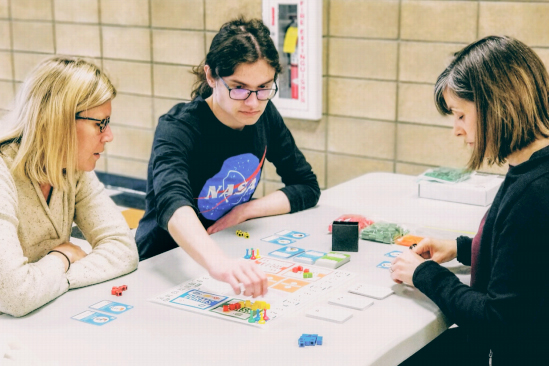
Imagine you’re a college first year, and you have a big test tomorrow. Are you going to spend tonight studying, or will you meet friends for sushi?
Or say you go to a party and meet some new people. Are you going to become friends with Derek, who gossips a lot and stresses you out -- but helps you study for chemistry -- or will you become friends with Alyssa, who distracts you from your homework but pays for your coffee every time?
And in your free time this weekend, will you go to a student group’s getting-to-know-you dinner or attend a presentation on financial literacy?
These are the kinds of life choices that college students face every day. Throw into the mix unpredictable life events -- your computer breaks, you embarrass yourself at a party, your grandpa sends you a check for your birthday -- and you’ve got all the elements that high schoolers must learn to successfully navigate as they transition into campus life.
To help high school students understand the need to balance various aspects of their lives -- academics, work, friends, and finances -- and how to find resources when needed, Tricia Seifert, Montana State University, and Kirsty Wadsley, London School of Economics and Political Science, decided, literally, to make a game of it.
Catalyzed at SEM ‘17
The seed of the idea took root at 2017 AACRAO SEM Conference. At the conclusion of her keynote address, Seifert shared her thoughts about using gaming to help students transition from high school to college, showing slides of a beta game she was working on with some students.
“It was at that SEM Conference that I met Kirsty Wadsley who works in widening participation, and we talked about this idea, and our conversations continued and grew from there,” Seifert said. “Once I got back from the conference in Phoenix, I reached out to student game developers and they just took off on this project. I’m so excited that just a year ago I shared these very preliminary concepts, which led to a really key relationship formed at SEM, and now I have something amazing.”
Wadsley flew to Montana last May, at which point Seifert’s team had produced five prototypes of the Blueprints for Student Success board game, and they went on a 1000 mile-road trip along the Montana Hi-line (Hwy 2 just south of the Canadian border) to play the game in some of the most rural communities in the state.
Game play: Teaching kids how to ‘do college’
Tabletop University invites players to manage their time to best create school/life balance (a.k.a. How to "do college,” Seifert joked). The object of the game is to maximize your score on two different tracks -- academics (GPA) and social -- while not losing any points to stress or lack of finances. The key mechanism for making decisions is deciding how to spend the limited blocks of time allocated at the beginning of each “week.” (Sound relatable?)
“The strategy comes from deciding how to use your time across all the different possibilities -- social activities, studying, working, going to class, utilizing campus services, and so on,” Seifert said. “If you use up all your time, you have stress.” And if you don’t have sufficient coins at the game’s conclusion, you can’t pay for next semester’s tuition.
The winner is based on a combination of total score on the GPA scale plus total score on the scale, minus accumulated stress. A perfect score is 30 -- 15 GPA, 15 social, and no points lost to stress or insufficient funds.
“I’ll be honest, just like in real life, I’ve never seen a perfect score -- just like i’ve never seen a perfect semester,” Seifert said in a YouTube video describing the theory behind the game. “Part of college is figuring out the balance, and that’s what the strategy is here in this game.”
The future of Tabletop University: Blueprint app, international comparison, and more
“The feedback has been out of this world,” Seifert said. “I couldn’t have envisioned the response. Students think it’s fun -- and say it’s something that could help them in real life.”
Students often get a lot of information about applying for admissions and for financial aid, often don’t get a sense of what college life is really like.
“As I’ve shared this at schools I’ve gotten interest from others besides just college counselors -- teachers have really gravitated to the possibilities, like English teachers using it to align with a college essay writing prompt, or business or careers class using it to engage students in discussion. They tell me ‘this is what I need to have conversations with students,’” Seifert said. “Plus, it’s super duper fun to play.”
Next up, the Blueprint team is looking at launching a mobile app version of the game, as well as a Kickstarter campaign to manufacture the board game and make it available to more high schools.
Seifert has continued to travel across Montana, and in some of the most remote schools in the U.S., with her three copies of the game. Two copies went with Wadsley back to London, where students in one of the most cosmopolitan cities in the world are playing the game.
They’ll share their insights on their experience with transatlantic gaming and more information about the game in their Blueprints for Student Success session at the 2018 AACRAO SEM Conference in November. Learn more and register now.